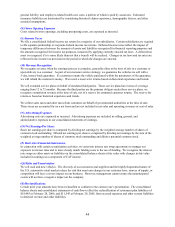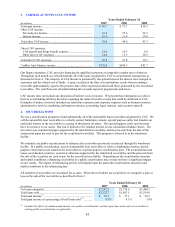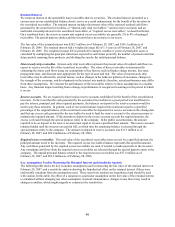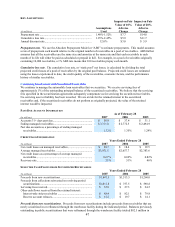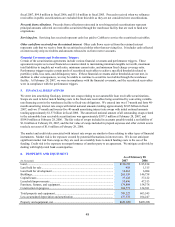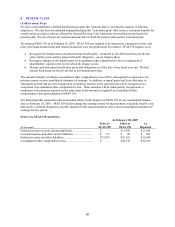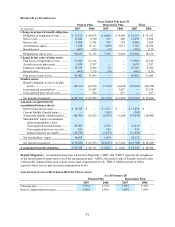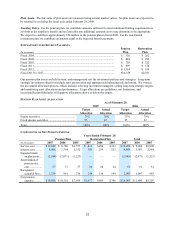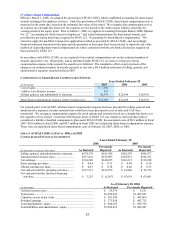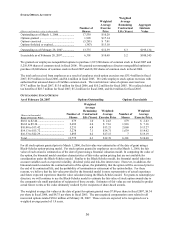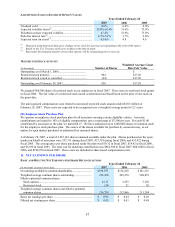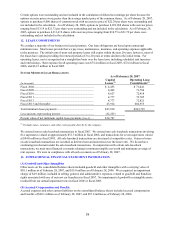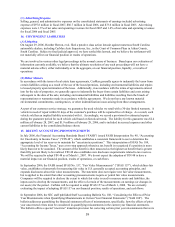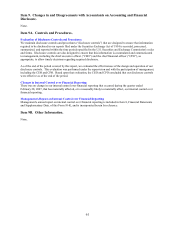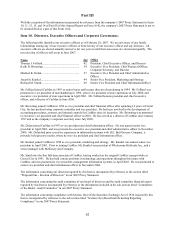CarMax 2007 Annual Report Download - page 63
Download and view the complete annual report
Please find page 63 of the 2007 CarMax annual report below. You can navigate through the pages in the report by either clicking on the pages listed below, or by using the keyword search tool below to find specific information within the annual report.
53
The estimated actuarial loss and prior service cost for the pension plan that will be amortized from accumulated
other comprehensive loss over the next fiscal year are $2.1 million and $37,000, respectively. The estimated
actuarial loss and prior service cost for the restoration plan that will be amortized from accumulated other
comprehensive loss over the next fiscal year are $182,000 and $24,000, respectively.
ASSUMPTIONS USED TO DETERMINE NET PENSION EXPENSE
Years Ended February 28
Pension Plan Restoration Plan
2007 2006 2005 2007 2006 2005
Discount rate................................................... 5.75% 5.75% 6.00% 5.75% 5.75% 6.00%
Expected rate of return on plan assets ............ 8.00% 8.00% 8.00% — — —
Rate of compensation increase ....................... 5.00% 5.00% 5.00% 7.00% 7.00% 7.00%
Assumptions. Underlying both the calculation of the PBO and the net pension expense are actuarial calculations of
each plan's liability. These calculations use participant-specific information such as salary, age, and years of
service, as well as certain assumptions, the most significant being the discount rate, expected rate of return on plan
assets, rate of compensation increases, and mortality rate. We evaluate these assumptions annually, at a minimum,
and make changes as necessary.
The discount rate used for retirement benefit plan accounting reflects the yields available on high-quality, fixed
income debt instruments. For our plans, we review high-quality corporate bond indices in addition to a hypothetical
portfolio of corporate bonds with maturities that approximate the expected timing of the anticipated benefit
payments.
To determine the expected long-term return on plan assets, we consider the current and expected asset allocations, as
well as historical and expected returns on various categories of plan assets. We apply the expected rate of return to a
market-related value of assets, which reduces the underlying variability in the asset values. The use of expected
long-term rates of return on pension plan assets may result in recognized asset returns that are greater or less than
the actual returns of those pension plan assets in any given year. Over time, however, the expected long-term
returns are anticipated to approximate the actual long-term returns and therefore result in a pattern of income and
expense recognition that more closely matches the pattern of the services provided by the employees. Differences
between actual and expected returns, a component of unrecognized actuarial gains/losses, are recognized over the
average future expected service of the active employees in the pension plan.
We determine the rate of compensation increases based upon our long-term plans for such increases. Mortality rate
assumptions are based on the life expectancy of the population and were updated as of February 28, 2006, to account
for recent increases in life expectancy.
(B) 401(k) Plan
We sponsor a 401(k) plan for all associates meeting certain eligibility criteria. Under the plan, eligible associates
can contribute up to 40% of their salaries, and we match a portion of those contributions. The total cost for
matching contributions was $2.7 million in fiscal 2007, $2.0 million in fiscal 2006, and $1.5 million in fiscal 2005.
9. DEBT
As of February 28
(In thousands) 2007 2006
Revolving credit agreement......................................................................................... $150,690 $ 159,263
Obligations under capital leases .................................................................................. 34,787 35,749
Total debt..................................................................................................................... 185,477 195,012
Less current portion:
Revolving credit agreement.................................................................................... 150,690 59,263
Obligations under capital leases............................................................................. 1,043 962
Total long-term debt, excluding current portion.......................................................... $ 33,744 $ 134,787
CarMax has a $500 million, five year revolving credit facility (the “credit agreement”) with Bank of America, N.A.
and various other financial institutions. The credit agreement is secured by vehicle inventory and contains
customary representations and warranties, conditions, and covenants. Borrowings accrue interest at variable rates



